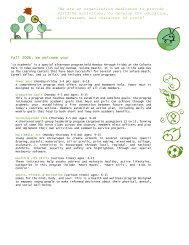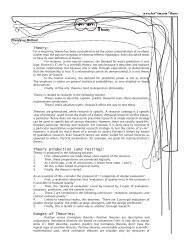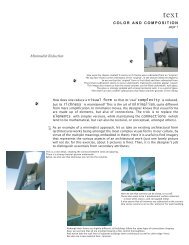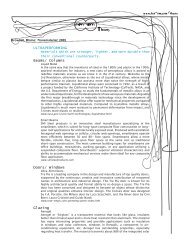HTML-CSS Animation - fen-om data
HTML-CSS Animation - fen-om data
HTML-CSS Animation - fen-om data
Create successful ePaper yourself
Turn your PDF publications into a flip-book with our unique Google optimized e-Paper software.
"With the Flash Professional Toolkit for CreateJS, you can now easily export assets and animations to<br />
JavaScript using the open source CreateJS framework. The output generates nicely formatted, readable,<br />
and editable JavaScript code."<br />
As opposed to Wallaby, which produced fairly hermetic/self-contained 'final' code, the CreateJS toolkit<br />
has been conceived to sacrifice s<strong>om</strong>e level of final product (since editing is always necessary); it opts to<br />
do a fairly good job in the export, while keeping clean code for easy editing and to leverage efficient<br />
designer-developer workflows. Also new (that didn't exist in Wallaby): audio support.<br />
The plug-in outputs an html and a js file, together with assets in 3 folders: images, libs (for any necessary<br />
CreateJS libraries), sounds. It's very easy then for a developer to add further interactivity.<br />
Beware (best practices):<br />
• <strong>Animation</strong> c<strong>om</strong>plexity: CreateJS supports Flash timeline animations (with classic tweens applied<br />
to only one symbol at a time).<br />
• Fonts: Fonts are not embedded in the published output. Either use web safe fonts, or ensure<br />
you make the fonts available in your project using web fonts for <strong>CSS</strong>.<br />
• Transformations: CreateJS supports shape transformations and alpha transparency values.<br />
• Asset naming: Name everything correctly (layers, elements, etc), because these are the names<br />
you'll later be looking for in the exported JavaScript code. For symbol naming, CreateJS uses<br />
these in order of preference: the ActionScript 3 class name, the symbol name.<br />
• Frames: CreateJS starts frame numbers at 0 whereas Flash starts at 1 (so EaselJS frame numbers<br />
are always be one less than what you see in Flash). For this reason, it's easier to use frame labels<br />
instead of numbers (when you need to refer to a frame in your animation).<br />
• JavaScript in Flash: You can start to add JavaScript to your Flash animation even before<br />
exporting your project, by embedding the JavaScript code inside a special /* js c<strong>om</strong>ment block<br />
(ActionScript is ignored in what is published fr<strong>om</strong> Toolkit, and anything within the /* js block is<br />
ignored in Flash Player). It's best to leave the bulk of JavaScript for after the html has been<br />
exported, though. Stick to code that controls the timeline.<br />
Page 2








